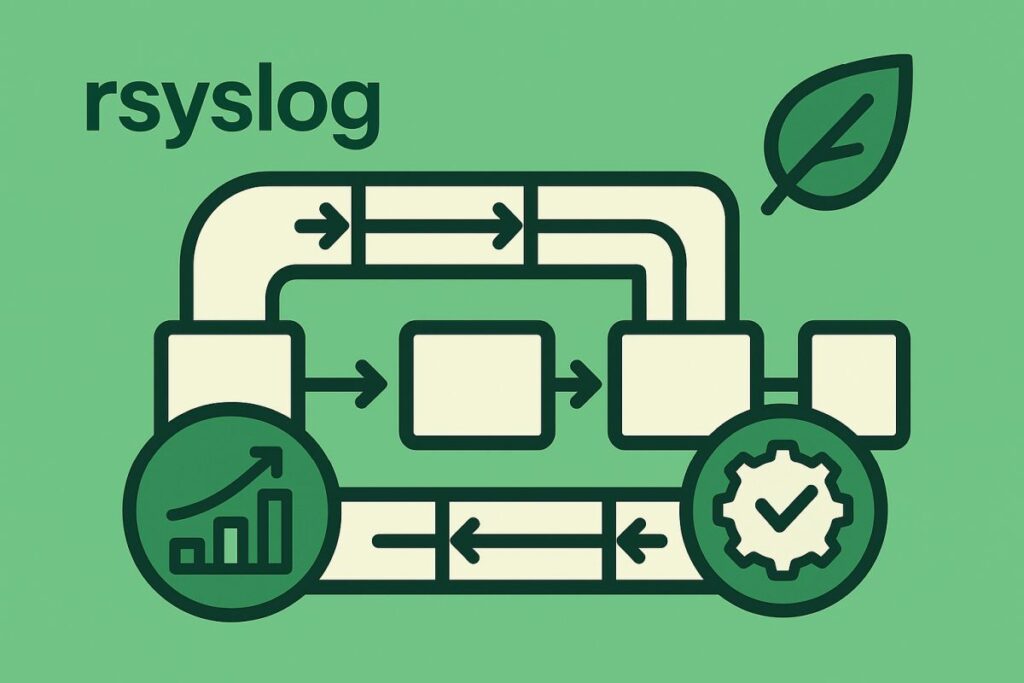Designing Cost-Efficient and Sustainable Log Pipelines With Rsyslog
For readers who prefer a compact Computer Science style model of the concepts discussed, you will find a concise CS summary at the end of this article.
Modern logging pipelines generate far more data than most platforms can process cost-effectively. Commercial SIEMs, cloud logging services, and large-scale analytics backends typically use pricing models tied to events per second (EPS) or ingest volume. Every unnecessary log message therefore increases cost, CPU load, network traffic, and energy consumption.
Rsyslog provides a flexible architecture that helps control these effects long before data reaches expensive systems. This article explains how rsyslog can be used to build leaner, cheaper, and more sustainable log pipelines without losing the visibility required for operations or compliance.

Rsyslog’s efficiency comes from its implementation: performance-critical code is written in C, designed for high-throughput workloads, and optimized through years of production use. This allows filtering, routing, and transformation with minimal overhead.
1. Multi-Stage Reduction: More Than Just Edge Filtering
Rsyslog is commonly deployed at the edge, but it also operates efficiently as a routing and reduction layer inside larger pipelines. Multi-hop topologies are standard in modern platforms, for example:
application → node collector → relay → SIEM / archiveAt each hop, rsyslog can apply rules to:
- drop obvious noise
- rewrite or normalize messages
- split data into separate routes
- aggregate or buffer events
Small reductions at multiple stages compound into large savings at the backend. Because rsyslog’s filtering logic is deterministic and low-overhead, these operations add very little cost at the source but significantly reduce cost and load downstream.
2. Tiered Routing: One Ingest Path, Multiple Destinations
A frequent design challenge is that different consumers need different kinds of data. Some logs are required for real-time security analytics, while others only need long-term retention for compliance.
Rsyslog can route all of these from a single ingestion path:
- High-value events → forwarded to SIEM or analytics systems
- Low-value or low-urgency events → stored in inexpensive object storage or archival systems
- Noise → optionally dropped
This avoids duplicate agents and parallel pipelines. High-cost destinations only receive the messages that are truly relevant to them.
3. Balancing Reduction and Visibility
Any reduction step raises a natural question: What if something important is removed? Rsyslog’s filtering is deterministic, but operators still need insight into what is being discarded.
A future enhancement under evaluation is the ability to generate reduction statistics for dropped messages. These statistics could include:
- which rule or message pattern caused the drop
- how many messages were affected
- per-pattern or per-cluster counts
- time-bucket summaries for trend analysis
Such metadata would let operators verify that filters behave as intended, while still gaining the cost and energy benefits of eliminating noise. Backends that understand these statistics could further detect unexpected changes in message patterns.
This feature does not yet exist, but the concept fits the practical need for transparency while enabling leaner pipelines. Please contat the rsyslog team if you are interested in these features.
4. FinOps and Green IT Benefits
Applying filtering and routing at several points in the pipeline has direct operational advantages.
Reduced SIEM and cloud logging costs
By lowering the EPS rate before it reaches cost-sensitive systems, organizations reduce variable ingest charges immediately and consistently.
Lower infrastructure load
Less data means fewer CPU cycles and IO operations. Systems become more responsive, and fewer nodes are required for indexing, parsing, or storage.
Energy savings
Every message that is not transmitted or processed avoids compute, network, and cooling overhead. Rsyslog’s lightweight design ensures that reduction happens with minimal impact at the source.
5. A Foundation for Leaner Pipelines
Rsyslog’s flexibility makes it useful not only as a traditional syslog daemon but as a modern log-routing fabric capable of shaping traffic across multiple pipeline layers. Multi-stage reduction, tiered routing, and the concept of reduction statistics provide a practical path toward leaner pipelines that remain compliant and operationally safe.
These capabilities already power large-scale production deployments in enterprises and service providers. As logging costs continue to rise and sustainability requirements tighten, efficient pipeline design will become an increasingly important part of real-world observability strategies.
Concise CS Summary
This section summarizes the article through a Computer Science lens, offering a compact conceptual model for engineering-oriented readers.
- Multi-stage reduction applies classical pipeline optimization: each stage prunes complexity and volume, reducing downstream cost and load.
- Deterministic filtering implements early decision-making with predictable semantics, minimizing unnecessary data propagation.
- Tiered routing is an information-flow partitioning strategy, mapping message classes to cost-appropriate sinks.
- Reduction statistics represent metadata for transformation provenance, enabling verification of correctness and behavioural drift detection.
- Energy impact follows amortized analysis: each dropped message avoids compute, memory, storage, and cooling overhead along the entire pipeline.
- Cost behaviour is governed by asymptotic effects: small reductions early compound into large reductions at O(n) and O(n log n) backends.
- Rsyslog functions as a low-overhead routing fabric in a distributed system, providing efficient, verifiable control over log information flow.
